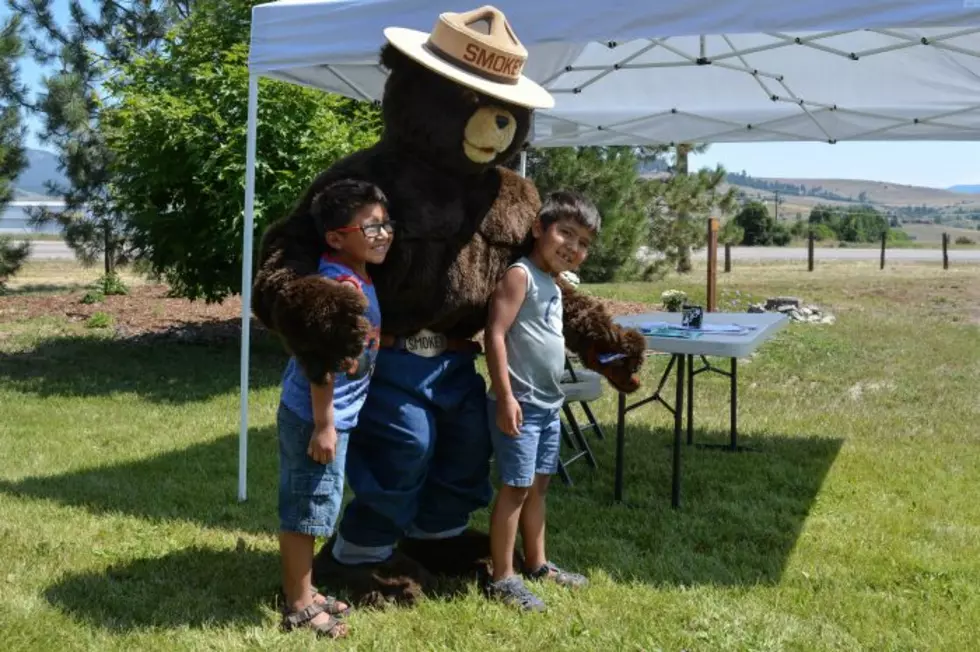
Smokey Bear turns 75, and Missoula throws a party
Fortunately, there were no mishaps with birthday candles at Smokey Bear’s 75th anniversary celebration Saturday afternoon at the National Museum of Forest Service History west of Missoula.
His 50th birthday party in 1994 was a different story.
A commercial depicted Smokey's woodland animal friends waiting to surprise him with a cake. Smokey was led to the party blindfolded. When he smelled smoke, he didn’t realize it was the candles and instinctively used his shovel to put out the fire, smashing his cake in the process.
A poster made that same year shows Smokey with a cake topped with extinguished candles and the message: “Make Smokey’s Birthday Wish Come True!”
Several hundred people were on hand to wish the firefighting bruin happy birthday at Saturday's celebration. It was a free, family oriented event, which included games, watermelon-eating contests, food trucks, live music, storytelling by Montana Public Radio’s Annie Garde, and a bird show by Raptor of the Rockies. Ollie Osprey and Woodsy Owl were also there to help Smokey celebrate.
“Smokey is 75, and we’re here to celebrate!” said Museum Executive Director Lisa Tate.
The event was sponsored by Blackfoot Communications and Humanities Montana. Pepsi-Cola of Missoula provided free water and Gatorade, and Albertsons donated watermelons and birthday cake.
Smokey Bear was created in 1944 by artist Albert Staehle, in collaboration with writer and art critic Harold Rosenberg, as part of the Wildfire Prevention Campaign – the longest-running public service campaign in the United States – for the U.S. Forest Service, Advertising Council and the National Association of State Foresters.
His original slogan was, “Smokey Says – Care Will Prevent 9 out of 10 Forest Fires,” which was changed a few years later to the more familiar, “Only YOU Can Prevent Forest Fires.”
At the time, with many firefighters overseas during World War II, Forest Service officials were worried about the lack of resources to fight fire and emphasized prevention. At the same time, the Japanese military was attempting to ignite forest fires in the western United States. Between 1944 and 1945, the Japanese released an estimated 9,000 fire balloons, also called “balloon bombs,” into air currents directed toward the United States. About 1,000 reached the West Coast. (On May 5, 1945, one of the balloons killed five schoolchildren and their teacher, Elsie Mitchell, in Bly, Oregon.)
The Forest Service had created a Cooperative Forest Fire Prevention Program and, on August 9, 1944 – after a year of using Walt Disney’s Bambi to promote their message – adopted Smokey Bear as the new mascot. He was named in honor of “Smokey Joe” Martin of the New York City Fire Department, who had become a national hero after suffering burns and blindness fighting an explosive warehouse fire in 1922.
A living version of Smokey came along in the spring of 1950 when, during a wildfire in the Capitan Mountains of New Mexico, on the Lincoln National Forest, a five-pound, three-month-old black bear cub was rescued from a tree by firefighters. His paws and hindlegs had been badly burned.
The story received widespread coverage and the bear, originally known as “Hotfoot Teddy,” became a national celebrity. After recovering, the cub was renamed “Smokey” and was moved to the National Zoo in Washington, D.C., where he lived out the rest of his 26-year life. His story is often used to explain the origins of Smokey Bear.
According to the U.S. Postal Service, Smokey received about 13,000 letters a week at the National Zoo, and was given his own zip code, “20252,” which is still in use. His name and image are also protected by the Smokey Bear Act of 1952, which removed Smokey from the public domain and placed him under control of the U.S. Secretary of Agriculture. The Act also requires Smokey’s royalties from various merchandise (T-shirts, stuffed animals, dolls, books) be used for public education efforts regarding wildfire prevention. On his 40th birthday in 1984, Smokey was honored with his own U.S. postage stamp depicting a cup hanging onto a burnt tree, illustrated by Rudy Wendelin.
In 1952, Eddy Arnold performed his “Smokey the Bear” song. Throughout the 1950s and 1960s, the Ad Council sponsored radio spots featuring Smokey chatting with various celebrities including Bing Crosby, Art Linkletter, Dinah Shore and Roy Rogers.
Like most celebrities under the public spotlight, Smokey’s life hasn’t been without controversy and criticism. Many forest ecologists and policy makers have expressed concern over the years that Smokey’s messages have contributed to overzealous policies of fire suppression, altering forests that evolved with and depend on frequent, periodic wildfire – such as the low-elevation ponderosa pine forests around Missoula – resulting in conversions to denser, dead and dying forests of Douglas fir and grand fir and, ironically, increased fire risks.
As a result, Smokey’s messages have evolved over the years to reflect changing knowledge of, and attitudes toward wildlands and wildfires. In 2001, Smokey’s slogan was changed from “Only YOU can prevent forest fires” to “Only YOU can prevent wildfires,” to include all wildland fires, including grasslands. His messages have also been changed to help educate and inform people about the natural role of wildfire in creating and maintaining various forest types, and the benefits of prescribed burns. There’s even a section on his website called “Benefits of Fire.” He now emphasizes the need to prevent “human-caused” fires and to “protect and reduce the loss of homes, other structures and lives.”
Prevention is still key. Throughout his distinguished 75-year life and career, these words from Smokey have remained consistent and relevant: “Break Your Matches,” “Crush Your Smokes,” “Be Careful with EVERY Fire,” “Drown Your Campfires,” “Don’t Play with Matches,” and “Remember: Only YOU Can Prevent Wildfires.”
For more about Smokey (including a 75th Birthday message from Comedian Stephen Colbert), check out his website at: www.smokeybear.com .
